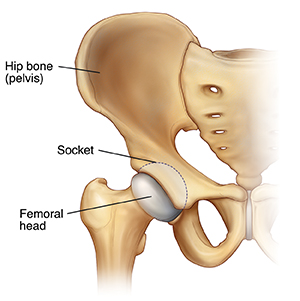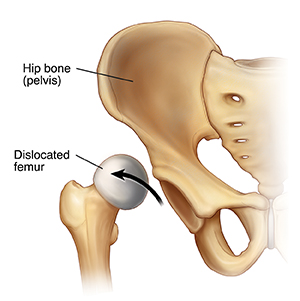When Your Child Has Developmental Dysplasia of the Hip
Your child has been diagnosed with developmental dysplasia of the hip (DDH). Hip dysplasia (also called hip dislocation) is a problem with the hip joint. This condition is congenital, meaning it’s present at birth. It is not often painful. And it is very treatable in young children. If your child has this problem, they may see a pediatric orthopedist. This is a healthcare provider specializing in treating bone and joint problems in children.
What causes developmental hip dysplasia?
Developmental hip dysplasia happens when the rounded top of the leg bone (the femoral head) slips partly or completely out of the hip socket. The hip socket may be too small or too shallow. This problem is more common in female children, in firstborn children, and in children born into families with a history of this condition. It is also more common in babies who are positioned feet first (breech) in the uterus.


What are the signs of developmental hip dysplasia?
Signs of this problem may be noted at birth. But the hip may also seem fine at birth and not show problems until later weeks. Common signs include:
-
A hip that is dislocated at birth
-
A hip that is “loose” (this may get worse as the child grows and becomes more active)
-
A hip that is less flexible than normal
-
A shorter leg, or a leg that turns outward (on the side of the dysplasia)
-
Uneven skin folds on the thighs or buttocks
-
Limping, walking on the toes, or a waddling “duck-like” gait in children who have begun to walk
How is developmental hip dysplasia diagnosed?
The condition may be noticed just after birth. Or it may not be found until later screenings are done. Very mild cases may not be noticed until the child begins to walk. If this problem is suspected, imaging tests such as an ultrasound or an X-ray may be done to confirm the diagnosis.
How is developmental hip dysplasia treated?
In 1 in 4 children with hip dysplasia, the problem goes away without treatment. If treatment is needed, the options depend on the child’s age:
-
Babies. A Pavlik harness is used for 1 to 3 months. This harness holds the hip joint in place so the tissues around the joint can tighten and hold the joint in normal position. Once the harness is removed, the child should grow and develop normally. In some cases, a hip abduction brace is needed to help keep the legs in position.
-
Children 6 months and older. A procedure called closed reduction may be done. This moves the hip joint into place without surgery. In some cases, surgery may be needed to move the hip joint into place. After either closed reduction or surgery, a cast is put on the leg and hip to hold the joint in place. The cast may stay on for several months. Once the cast is removed, the child should grow and develop normally.
What are the long-term concerns?
After hip dysplasia goes away on its own or is treated, most children grow normally. But if the dysplasia remains and isn’t treated, long-term joint problems can result. So to be sure there are no lingering problems, your child will likely need to see the healthcare provider regularly for monitoring. This is usually done at ages 6 months, 12 months, 4 to 6 years, and 14 years, or as directed.
Online Medical Reviewer:
Rahul Banerjee MD
Online Medical Reviewer:
Raymond Turley Jr PA-C
Online Medical Reviewer:
Rita Sather RN
Date Last Reviewed:
10/1/2024
© 2000-2025 The StayWell Company, LLC. All rights reserved. This information is not intended as a substitute for professional medical care. Always follow your healthcare professional's instructions.